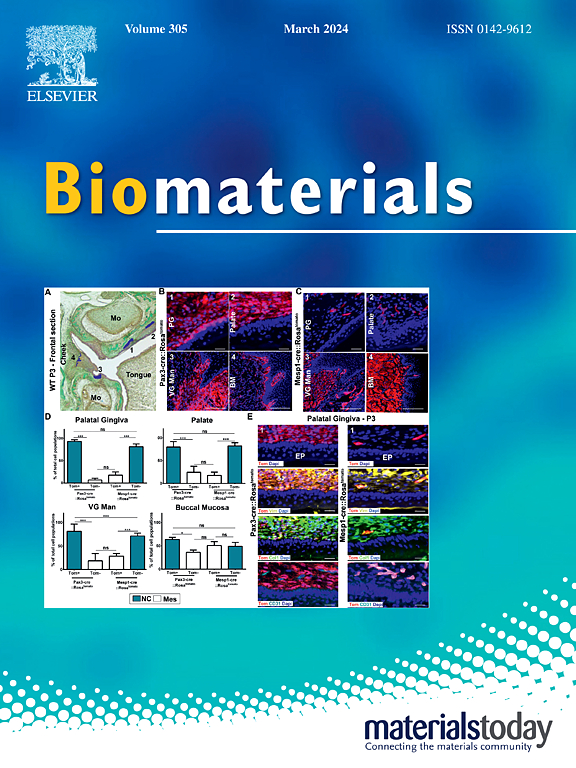Photoinitiated CVD antifouling coatings enable long-term stability of flexible multifunctional neural probes for chronic neural recording
IF 12.8
1区 医学
Q1 ENGINEERING, BIOMEDICAL
引用次数: 0
Abstract
Flexible neural probes with integrated recording, optical stimulation, and drug delivery capabilities offer unprecedented access to neural circuit dynamics. However, their long-term utility is compromised by foreign body responses that isolate recording sites from target neurons. This study introduces photoinitiated chemical vapor deposition (piCVD) as a transformative approach to neural interface stability through ultrathin (<100 nm) anti-fouling coatings. Unlike conventional hydrogel coatings that impair electrical signal transmission, our piCVD-applied poly(2-hydroxyethyl methacrylate-co-ethylene glycol dimethacrylate) coating maintains electrical functionality by preserving low impedance while providing superior anti-fouling properties. In vitro protein adsorption studies demonstrated near-complete resistance to both albumin and fibrinogen compared to uncoated surfaces, with the coating maintaining stability even after 24 h of sonication—durability unachievable with conventional wet-chemistry methods. When evaluated in mouse models over three months, the coated probe maintained high-quality spontaneous neural recordings and optically evoked potentials throughout the study period, with signal-to-noise ratios improving from 18.0 at week 1–20.7 at week 13. This performance significantly correlates with 66.6 % reduction in glial scarring, 84.6 % increase in neuronal preservation compared to uncoated probes. The specific combination of CVD methodology and optimized copolymer composition achieves long-term stability, representing a significant advance over the typical one-month limitation of conventional coatings. These results establish piCVD antifouling coatings as an enabling technology for chronic neural interfaces in both basic neuroscience research and emerging neuroprosthetic applications.

光引发CVD防污涂层使柔性多功能神经探针能够长期稳定地用于慢性神经记录
具有集成记录、光学刺激和药物传递能力的柔性神经探针为神经回路动力学提供了前所未有的途径。然而,它们的长期效用受到异物反应的影响,这些反应使记录位点与目标神经元分离。本研究介绍了光引发化学气相沉积(piCVD)作为一种通过超薄(100纳米)防污涂层来提高神经界面稳定性的革命性方法。与传统水凝胶涂层影响电信号传输不同,我们的picvd涂层通过保持低阻抗来保持电气功能,同时提供卓越的防污性能。体外蛋白质吸附研究表明,与未涂覆的表面相比,该涂层对白蛋白和纤维蛋白原具有近乎完全的抗性,即使在24小时的超声处理后也能保持稳定性,这是传统湿化学方法无法实现的。当在小鼠模型中进行三个月的评估时,涂层探针在整个研究期间保持了高质量的自发神经记录和光诱发电位,信噪比从第1周的18.0提高到第13周的20.7。与未包被探针相比,这种性能显著降低了66.6%的胶质瘢痕,增加了84.6%的神经元保存。CVD方法和优化共聚物组成的特定组合实现了长期稳定性,代表了传统涂料典型的一个月限制的重大进步。这些结果确立了piCVD防污涂层作为基础神经科学研究和新兴神经假肢应用中慢性神经界面的使能技术。
本文章由计算机程序翻译,如有差异,请以英文原文为准。
求助全文
约1分钟内获得全文
求助全文
来源期刊

Biomaterials
工程技术-材料科学:生物材料
CiteScore
26.00
自引率
2.90%
发文量
565
审稿时长
46 days
期刊介绍:
Biomaterials is an international journal covering the science and clinical application of biomaterials. A biomaterial is now defined as a substance that has been engineered to take a form which, alone or as part of a complex system, is used to direct, by control of interactions with components of living systems, the course of any therapeutic or diagnostic procedure. It is the aim of the journal to provide a peer-reviewed forum for the publication of original papers and authoritative review and opinion papers dealing with the most important issues facing the use of biomaterials in clinical practice. The scope of the journal covers the wide range of physical, biological and chemical sciences that underpin the design of biomaterials and the clinical disciplines in which they are used. These sciences include polymer synthesis and characterization, drug and gene vector design, the biology of the host response, immunology and toxicology and self assembly at the nanoscale. Clinical applications include the therapies of medical technology and regenerative medicine in all clinical disciplines, and diagnostic systems that reply on innovative contrast and sensing agents. The journal is relevant to areas such as cancer diagnosis and therapy, implantable devices, drug delivery systems, gene vectors, bionanotechnology and tissue engineering.
 求助内容:
求助内容: 应助结果提醒方式:
应助结果提醒方式:


